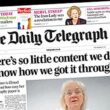Tony Elliott, the founder of Time Out, has died in London aged 73 after a long battle with cancer.
He started Time Out magazine in London in 1968 and grew it into a major international publishing business. Time Out said yesterday (17 July): “Tony was a visionary publisher, a tireless champion of city culture and a staunch friend. He will be sorely missed by his family, friends and colleagues. His life and his work inspired millions of people who did not have the good fortune to know him personally.”
In tribute to the man who inspired so many people in the media, the arts and culture in Britain and around the world, we reproduce a Flashes & Flames story from 16 June 2016
Tony emailed afterwards: “It’s very good and well informed. One of the best pieces on the past, present and future of Time Out. Thank you. Condé Nast never actually offered £100m! Alas. I always thought they would be perfect partners.”
Tony, We will miss your wit, wisdom, friendship and fun. We all owe you so much.
Tony Elliott CBE 1947-2020. RIP
Can Time Out become a new media model?
16 June 2016: No media business is even close to where it wants to be. Traditional companies struggle to hang on to print cashflows while competing with digital newbies which have all the flair but no sustainable profits. Young, digital-only, low-cost, small-team insurgents are fighting the unfair fight with the beasts of media pre-history. One business model is broken and the other is unproven. Neither side has all the pieces of the jigsaw: they need each other more than most of them realise.
That is why newspapers everywhere are watching Jeff Bezos’ Washington Post so closely. It’s the perfect case study: a strong newspaper brand and a fearless techxpert proprietor with deep pockets. It is also why magazine people everywhere will be watching Time Out, London-based publisher of the legendary entertainment listings magazine. It could become another perfect case study.
The 48-year-old global print brand was effectively rescued in 2010 by Peter Dubens, a low-profile, tech-focused investor, whose Oakley Capital last week sold the sizzle for Time Out’s IPO: “Since Oakley’s initial investment, Time Out has significantly grown and developed its digital media and e-commerce business, transitioned the magazines to a free print model in key geographies, consolidated the brand ownership by acquiring back the key licensee territories and acquired the Time Out food market in Lisbon, Portugal.”
Time Out ‘operates’ in 65 cities across 15 countries, notably London, New York and Paris, with licensing partners in a further 42 cities in 25 countries. It now claims its largest-ever audience reach of around 111m per month across all platforms, about 50% mobile.
That’s the footprint of a brand with 2015 revenues of £28.5m. But it’s also where the positive message ends. The company incurred operating losses of £18.5m (it’s many years since it was profitable). And – for all the talk of digitalisation – more than 50% of all revenues still come from print.
Attempts to profit from event and theatre ticket sales have so far failed to move the dial in an intensely competitive market. And the company lumps its digital advertising together with e-commerce revenue for the ‘benefit’ of investors who believe that such advertising is so much more valuable – and durable – than print. In that context, a trumpeted 10% increase in 2015 digital revenues seems modest, to say the least.
The new Time Out Plc board includes two former TripAdvisor executives, one of whom has claimed responsibility for growing that site’s traffic from 8m to 350m monthly uniques and reckons Time Out can do so too, “because of its rich ‘live’ content”. There’s a very long way to go because the currently claimed 111m global “readers” are the media-typical apples-and-pears aggregation of scores across both print and digital platforms. For now, it is impossible not to view Time Out as another traditional media business whose financial performance is less striking than its brand name.
It is not so much the e-commerce and online advertising that seems to hold the promise, but an international roll-out of the Time Out Market in Portugal. The Mercado da Ribeira – launched two years ago in a former Lisbon fish market – brings together mini-formats of many of the city’s best restaurants, food shops and culture under one roof, and currently attracts 35-65k people per week. It notched up 1.9m visitors in 2015 and was said to have become profitable in only 18 months.
The plan to internationalise the concept this month helped Time Out to raise £58m in the IPO on London’s AIM “junior” stock market, which valued the company at a surprisingly high £195m. The broker did great. But the shares immediately fell below the issue price as investors re-assessed the company’s chances of retail success.
It’s all so different from 1968. That was the dark year of the US assassinations of Martin Luther King and Bobby Kennedy, street battles in France, Russian tanks suppressing the Prague Spring, and violent anti-Vietnam war demonstrations in London. It was also the year when the 21-year-old London student Tony Elliott produced the first edition of Time Out from his mother’s kitchen table, on his summer vacation from Keele University.
The magazine started as a fold-up A5 black & white sheet. Elliott himself sold copies for one shilling (5p) on the streets across Central London. It covered the youth issues of the day including racial equality and police harassment. The first issue featured a Ronald Reagan movie season, and an “AgitProp” section which listed all the week’s political meetings and demonstrations. It invited readers to “meet the fuzz” at an anti-Vietnam war march.
Elliott was fascinated with the underground culture of 1960s London and the apparent need for reliable information about what was going on, in the arts, sports and political activism. Early issues even helped promote some well-publicised, illegal “squatting” at prominent (but unoccupied) London houses. Time Out was an instant success, and the ads started flowing in.
Over the years, the magazine shed its political roots and swelled to a 110,000-circulation weekly at its peak, but it remained the trendy voice of London. There were troubles along the way, including a 1981 strike by journalists who walked-out to start a co-operative-managed rival, City Limits, in protest at Elliott’s decision to scrap his policy of paying all journalists the same (yes). That lasted more than a decade, while Richard Branson’s well-funded rival, Event, closed after just six months.
Time Out gradually shed the politics and grew to become London’s leading lifestyle and listings magazine, then expanded into New York and other cities in the 1990s, as well as publishing best-selling city guides around the world. In the 1970s, Condé Nast was reported to have offered £100m to acquire it. Although the offer was never quite that high, Elliott came to regard the US owned glossy publisher as the perfect partner, the one that got away. There was no shortage of lesser suitors with which he flirted.
Tony Elliott was a media industry star who led the successful UK campaign to end the bizarre long-time restrictions which had effectively banned Time Out and others from publishing TV listings. Two decades later, he was largely responsible for forcing the State-owned BBC to dispose of its “unfairly competitive” magazines and books business after it had expensively acquired the Lonely Planet guides with which he competed directly.
But the history of Time Out has been punctuated by financial pressure. It has always had many more plans than cash.
Elliott was always determined to remain in sole control of his business. He has been a popular, enthusiastic and passionate boss who never quite trusted anyone else with his brainchild. A former colleague once said: “Tony is a suburban cottage industry. He’s essentially a small shopkeeper.”
But there have been times when it seemed so different. In 1995, he took his entire London staff of 140 to celebrate the launch of Time Out’s New York edition. He was expansive: “We’ve never had the money to do this until now. In the Eighties, we underwent a lot of expansion, and it’s only in the past four years that we’ve had the right financial people and the right staff to give us the strength to take on something as big as this.”
But, by 2004, the Time Out founder was saying: “The company was started with no money and we’ve traded for 36 years and constantly expanded using profits and bank backing. It’s reached the point when, if we could find the right financial backer, it would make a lot of sense for me to sell between 15-30% of the company to give it some working capital and so I can take a bit of money out.”
Three years later, when turnover was at least 25% higher than it is today, Elliott gave an unwitting clue to the company’s financial fragility in a newspaper interview: “One of the reasons my salary is so high is so I can service a huge mortgage on my £5m six-bedroom house in St John’s Wood. The plan was to reduce the mortgage by taking dividends out of the company in bite-size chunks over the years, but we’re continuously expanding so I’ve never done that. In the meantime, I end up being the bank guarantor for the business overdrafts because I’ve got such a valuable house, so I have to have it.”
Time Out had a number of very profitable years, but the founder seemed unconcerned about the losses in between. And, while the magazine industry was consolidating, Elliott clung to his independence. He had always been much more interested in ensuring the quality of magazine content than in managing the business fundamentals, even though he himself made almost all the company’s key decisions.
He frequently spent months with a succession of financial advisers and brokers discussing how to raise capital for the stretched business. But interested investors wanted to know how they could earn a return on their cash without a change in Time Out’s no-low profit strategy and/or an eventual sale of the business.
Elliott was having none of it. The result was that his widely-admired company perpetually lacked the funds to support its ambitious strategies. And that was even before digital disruption shook the foundations of print media everywhere.
While his magazine had survived an onslaught of new UK print listings rivals (including The Guardian’s 1993 introduction of an impressive free UK listings magazine), the web caught him flat-footed. Although, even now, few print publishers have yet to successfully conquer the web, Time Out’s listings content made it especially vulnerable to replication online.
The irony is that Tony Elliott was an early buyer – more than 10 years ago – of all the latest Apple gadgets, while Time Out itself was falling behind in media tech. Its cash-strapped sites around the world did not even share a common platform, which was always likely to impede growth.
Although the company subsequently developed its digital audience, it never had the robust strategy or the investment with which to counter falling advertising and copy sales (which eventually prompted the switch of most Time Out editions to free distribution).
The once-golden magazine gradually ran out of options.
In November 2010, Peter Dubens bought a 50% share in a deal which paid-off Elliott’s company and personal debt and valued Time Out at some £20m. The Time Out founder was enthusiastic: “I have considered many potential investors over the last seven years to help the brand with the next phase of development and I believe that Oakley Capital, with its entrepreneurial operational focus, will help us with this. I genuinely believe that I have found a real partner for what I expect to be a hugely successful worldwide digital journey.”
But the 50:50 partnership lasted only six months.
The business soon needed more cash and, in exchange, Oakley increased its shareholding to 66%. Tony Elliott had lost control. Before this month’s IPO, his shareholding had fallen further, to 2.6%. After the IPO, it is now just 1.4%. Having relinquished the chairmanship to Dubens, he now has the role only of a non-executive (and the only media-experienced) director of the company he created.
Time Out is a 48-year-old media parable. It pioneered a magazine style across entertainment listings, classifieds, and the arts in many cities, and went global with travel and restaurant guides. But the financials never quite caught up.
The upshot is that the founder – who had, for so long, been reluctant to reduce his 100% ownership – has lost the lot for a small fraction of the millions he once waved away. And, now, the company’s very survival depends primarily on the success not of media but of food markets. But, perhaps, Time Out can become a pioneer again – of “experiential” media.
Events are not new to media but their increasing prominence may reflect the growing need for community and real-life human contact among audiences otherwise connected only by the web. In B2B media, that is driving record results for trade exhibitions alongside the huge readership swing from print to digital. In consumer media, there are plans bubbling everywhere and some major success. In the US, Time Inc’s Essence Festival attracts more than 400,000 Essence magazine readers to New Orleans every year.
“This American Life”, the non-fiction radio programme that spawned the worldwide podcast hit Serial, has been putting on live shows for 15 years. There are sell-out worldwide conventions on science fiction, comics, Scandinavian crime thrillers and for fans of singers and movie actors.
The real break-through may be the live events of the US-based Pop-Up Magazine, created in 2009 by San Francisco journalist Doug McGray. He describes his ‘magazine’ as “new stories by filmmakers, photographers, writers, radio producers, illustrators, and musicians live on stage”.
Each event feature “articles” which are performed on stage in what are ephemeral multimedia performances of new works that are not live-streamed or recorded: they are only available to the “live” audience. Original soundtracks are composed as background for journalists presenting their narratives, along with interactive art, and live illustrations.
The whole format is magazine-like: Long features follow shorter, front-of-book style pieces, all of which are organized into familiar categories such as op-ed, sports, and education. Before they’re performed, the stories’ titles and bylines are projected onto a screen. And, afterwards, the performers and audience meet up over cocktails. The Columbia Journalism Review described Pop-Up as “performed journalism”.
It seems to be working: Pop-Up Magazine consistently sells out 3,000-person venues in Los Angeles, San Francisco, Oakland, and New York at ticket prices of $25-95. The venture – whose investors, intriguingly, include TED’s Chris Anderson and Facebook’s CPO Chris Cox – is worthy of study by magazine publishers everywhere.
Pop-Up provides possible context for Time Out, whose food markets could morph into experiential media with access to the sights, sounds and sensations of a city. The “market” could become the offline-online hub where young people eat, meet, make their plans, buy tickets, and immerse themselves in a metropolis with video, e-commerce, and live performance.
That ‘experience’ is, after all, what the pre-digital Time Out magazine has been facilitating in London and other cities for almost half a century. But, while there is every indication that the next Time Out Market will be in London, those broad media-retail-performance possibilities come only from my imagination: the company’s IPO prospectus simply describes a high-quality food market with free wifi.
So we will have to wait to see just how far this once so-creative media brand will actually push the boundaries. And the allocation of a mere £20m for the establishment of all five new indoor markets ( in London and, possibly, New York, Miami, Berlin and Porto) may even signal a distinct lack of ambition for a project whose newest investors are already feeling nervous. However, for all the talk of digital-retail revolution, more than one-third of Time Out employees are journalists-content producers: it is still pretty traditional media.
The future of the legendary brand is now down to the personable, un-flashy Peter Dubens. He’s certainly a different kind of private equity investor: a strategist and tenacious developer rather than a financial engineer. He could be just the person to do it for Time Out.
The experiential media dream could yet become a game-changer. Or it could be the last throw of the dice for a much-loved listings magazine that once seemed to have it all.





This analysis of Time Out is outstanding in explaining how traditional magazine brands have suffered as they have tried to make the transition to digital and find a viable new business model.